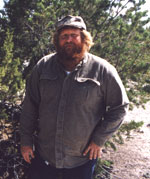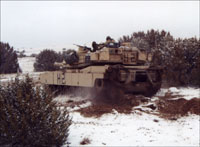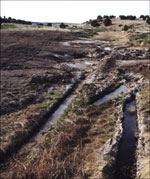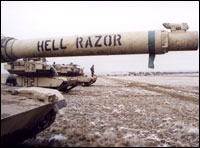The war is over and Dan Sharps is doing a body count. In a thicket of pinyon and juniper trees, something big and violent has cleared a path.

Dan Sharps as a tack.
Photo: David Mayfield.
“Lost arm,” Sharps says, gesturing toward one tree clipped of a big branch. “Lost leg,” he says, pointing to another.
Straight ahead lay the splinters of what was a large pinyon — a hearty tree but not when stomped on by an Army tank. “I’d pretty much call that one a fatality,” Sharps pronounces.
At the Army’s Pinon Canyon Maneuver Site in southern Colorado, this shaggy, red-bearded range conservationist has a tough job — to fix the damage done by the hundreds of tanks, armored fighting vehicles, and trucks that play war games on this fragile land several times a year.
Think of him as a mechanic with 237,000 acres to repair. Sharps, who works for the U.S. Fish and Wildlife Service, has been the backbone of land restoration at Pinon Canyon since shortly after the Army opened the maneuver site in 1985. He is the only year-round resident of the installation nestled alongside the Purgatoire River northeast of Trinidad.
It’s lonely work. Two-thirds of the year, there’s no Army presence, and only about a dozen civilians work at the site. Of them, nobody covers more ground than Sharps. He estimates he spends at least 90 percent of his time alone — regrading torn-up land, reseeding with native grasses and shrubs, building erosion-control structures.

At play in the fields of war.
Photo: David Mayfield.
His home on base is a rugged, old ranch house more than 10 miles from the nearest state road. He carts in his own drinking water and survives evenings without a TV by faithfully plowing through the boxes of books a librarian sister periodically mails him.
ptime he spends off-site is mostly to tend some nearby cropland that he bought six years ago. Friends wish he’d get out more, worrying that his devotion to Pinon Canyon has gotten the better of him. It’s the only place he’s worked since graduating from the University of Wyoming in 1986. But the soft-spoken Sharps says, “I don’t think I’d trade this for anything I know.”
Range Rover
Standing in the middle of the installation’s high prairie, he can turn a circle and look out across thousands of square miles, with stunning mountains like the twin snow-covered Spanish Peaks and the Sangre de Cristos just part of the backdrop. Descend into the redrock canyons, climb the basalt spine known as the Hogback, or wander through Pinon Canyon’s tens of thousands of acres of pinyon-juniper woodlands — and there are close-up wonders to explore.

In a rut.
Photo: David Mayfield.
Sharps can look at a grid map of the installation and, from his walking-around experiences, reel off some oddity, sublime or spectacular, in each of the hundreds of squares: a logjam of petrified wood, a fern-lined spring, a remnant of Ponderosa pine. He likes “going around looking at things.”
When it comes to Army impacts, the 40-year-old Sharps studies the land with the eye of a forensics examiner. He knows tank trails from the trails of Bradley fighting vehicles, Hemmets from Humvees — how long ago the vehicle left its mark, the wetness of the soil when it passed.
And everywhere he can gaze with pride on his own impact on the land, where he turned trenches and dug-out fighting positions back into grasslands through hours behind the wheel of a grader or a tractor, scooping out the little depressions where rain can settle, cross-stitch planting the seeds of western wheat grass, blue grama, alkali sacaton.
Sharps’s parents were geologists. The family moved throughout the West when he was growing up, but everywhere they went his dad planted trees. They spent their spare time outdoors, camping, fishing, hiking. Sharps studied range conservation at Wyoming, determined to make a living from working outside.
He arrived at Pinon Canyon not long after the Army had finished a long and bitter buyout of dozens of cattle ranches. Local residents predicted the Army would trash the land. Without doubt, the training impacts have been hard. There are places where the land is so rutted from tank traffic that a 5-mph ride in Sharps’s pickup turns into a head-banging bounce-a-thon.
But the Army has often delayed training after rains or snowfalls to allow the land to firm up. And it has built more than 160 small erosion-control dams that have actually reduced soil runoff into the Purgatoire.
The biggest change since the Army takeover is its banishing of cattle. Without competition from cows, Pinon Canyon’s antelope population has steadily grown, to over 1,300 at last count. Elk are flourishing as well. And many of the installation’s native grasses have recovered, to the point now that Army officials say the increasing plant cover will let fire take a larger role in shaping the landscape.
Casualities of War
Sharps thinks Pinon Canyon’s land condition is neither better nor worse, just different, with the Army presence. “Basically, we’ve traded cattle trails for tank trails and Humvee trails,” he says.

Cannon bawl.
Photo: David Mayfield.
He’s dismayed when Army units, most of which come from Fort Carson in Colorado Springs, destroy a lot of trees. About 400 pinyons and junipers, some hundreds-of-years-old, were flattened during two months of maneuvers that ended in March. Units whose commanders disregard recommendations to delay training until lands firm up after rain or snow cause some of the longest-lasting damage, he says.
“It just takes a few bad apples here and there to leave their marks for centuries,” Sharps says. “But for the most part, they’re pretty conscientious about what they’re doing.”
There’s little to do for the junipers and pinyons except to maintain the fences that put some of the woodlands off-limits to vehicles. Sharps mostly concentrates on recontouring and reseeding grasslands. About 3,000 acres are reseeded at Pinon Canyon each year. Much of it is by contract workers, but Sharps’ dusty flannel shirts testify to his hands-on penchant. Come summertime, when his allergies to seed dust grow most acute, so does his constant wheezing.
“July and August, I’m working on half a lung,” he says.
His hardest lesson has been accepting the fact that “anything I do has the potential to go back to ground zero again.” The Army often digs battle positions where he has worked hard to get grasses regrowing.
One afternoon earlier this year, Sharps is nudging his mud-splattered pickup up over a knoll in a far corner of Pinon Canyon. A blasting snow has cut visibility to 10 yards.
“Antelope,” he says matter-of-factly. A few seconds later, a half-dozen pronghorns dash in front of his truck. He’d smelled them first through his slightly rolled-down window.
These are the times he likes best on Pinon Canyon, Sharps says. When the weather’s socked in so tight, he navigates by his nose and his well-worn memories of the land’s contours. Nobody to rely on but himself.
Later, he says, “It would be nice if someday all of mankind realizes that we don’t have to have all these guns and tanks and the Army decides it doesn’t need a place like this.” Pinon Canyon would be perfect for a national wildlife refuge, with its mix of plain, woodl
and, and canyon habitats, he says. If ever it happens, “I’d like to be the guy in charge.”

